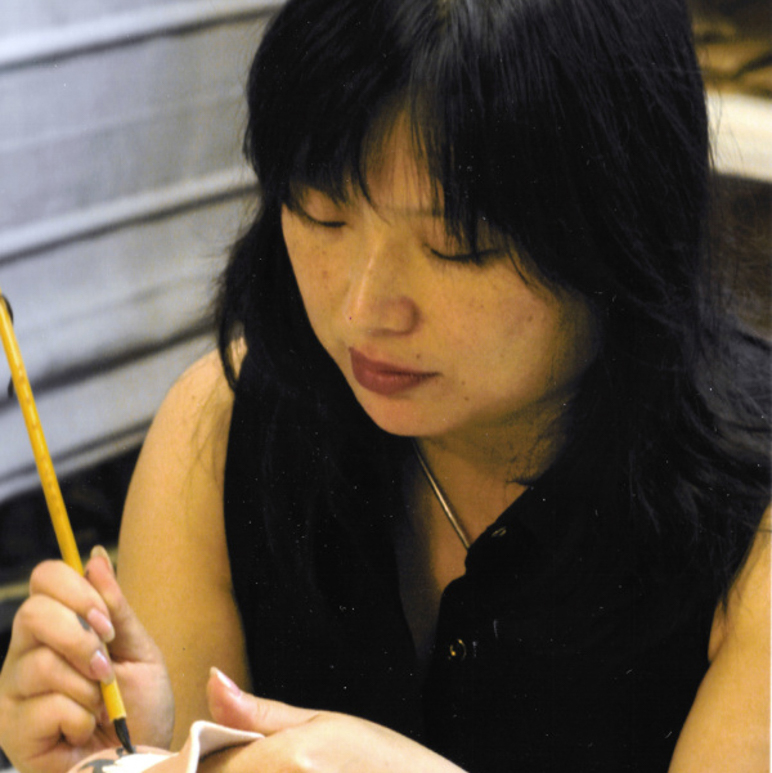
Mayco: Can you tell us a little bit about your style and introduction into pottery at a young age?
Tracie: My first pottery class was at my neighborhood art center in Southern California at age 12. I quickly wanted to move past pinch and coil pots, spiral wedging and learned to throw on a kick wheel. My mother wanted peony paintings for her house and sent me to a Chinese brushpainting class, which was a natural joining of two skills.
Mayco: Your brushpainting technique demonstrates history in modern application. What inspires your ideas for imagery? Form? Color?
Tracie: I am the daughter of a biology teacher so we were never refused potential pets and our house was always full of animals. My imagination plus the body language and gesture of animals and plants results in compositions that tell a story. When I survey my work, I noted consistent themes of hunger and love: birds gaze longingly, frog tracks a bug, bunnies snuggle. In a culture that equates food to love, the life themes of fulfillment, relationships and pleasure are strikingly present.
Mayco: If you had to define the art of Chinese Brushpainting in 4 words, which would you choose?
Tracie: Flow, Essence, Intention, Restraint
Mayco: How does using your technique differ with clay, paper and other mediums? What are the challenges? How do you divide your time?
Tracie: The materials differ slightly as I trade my clay and underglazes for rice paper and water-based color. Painting on pottery is more challenging than traditional rice paper and ink as flaws often are uncovered in a final glaze firing. I can instantly survey paintings on paper and start over if I need to. Although in Chinese art, there is a wet mount process at the end which is akin to a glaze firing that can be equally tricky to get finished work. Currently, I work mostly in clay, I teach on paper once a week and paint on paper like crazy when I have a show to hang. The best is when I get to exhibit paper and pottery together.
Mayco: How is your studio set up and what do you value about it?
Tracie: I work out of three places: home studio, community center studio where I teach, working studio-galleries, the Torpedo Factory Art Center, where I demonstrate and sell my work. Every artist betters themselves by teaching, which forces one to dissect the artwork and justify the why of everything while constantly practicing technique. One has constant fresh feedback that keeps me in check. In my working studio-gallery, I am able to meet and show my customers how handmade pottery comes into being, which adds value to the art form and adds education and story to a creation. My home studio looks onto my backyard so I meditate on my rabbit, Cleo on her daily hops, the bluebirds nesting, and natural inspiration.
Mayco: You have demonstrated your work using Mayco Underglazes numerous times. How do the Underglazes fit into your work or work for you?
Tracie: Mayco underglazes have a creamy consistency which is essential in Chinese brushpainting as multi-color shapes are made with a single stroke of the brush. The underglazes flow smoothly, the color is true and the reds, the lucky color for the Chinese, is beautiful and consistent.
Mayco: What have been the most influential and career changing experiences you have had? What about these experiences was so important?
Tracie: I had a long journalism career in newsrooms and then faced being a transient Army wife, so I retooled myself as a traveling and teaching fine arts. It was refreshing to go into an art center, ingratiate myself and teach a workshop. I blended my painting with pottery in Western Kentucky in a kismet meeting with Patricia Ferrell, a potter who invited me to work with her in her studio and refresh my childhood pottery skills. Be open to what comes; that is what sparks a creative nervous center.
Mayco: Could you give us a few examples of the symbolism within your work?
Tracie: Often Chinese symbolism is logical, once you think of it. Bamboo is one of my favorites, and it represents longevity, resilience, and flexibility, reflecting its persistent, hardy nature. Pandas are the perfect blend of yin and yang with their black and white coats and therefore embody perfection and balance. The rabbit is a celestial creature that lives in the heavenly moon and is known for its gentility and loyalty. Horses symbolize strength, fish are for prosperity.
Mayco: When you’re not making or promoting your work, what do you do for fun?
Tracie: Cooking new things, traveling to shop, eat and look at art and learning to whisper to rabbits and other animals.
Mayco: What would be an ideal basic set of materials to invest in if you’re an artist interested in trying Chinese brushpainting for the first time?
Tracie: High-quality wolf hair brushes; try them out first!